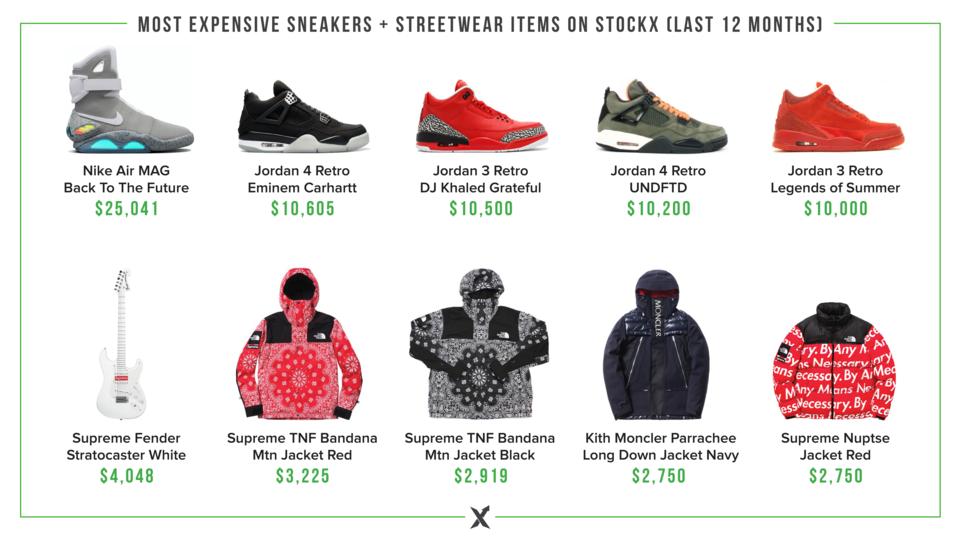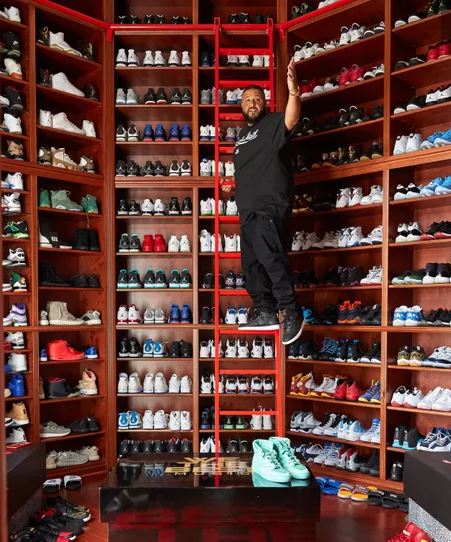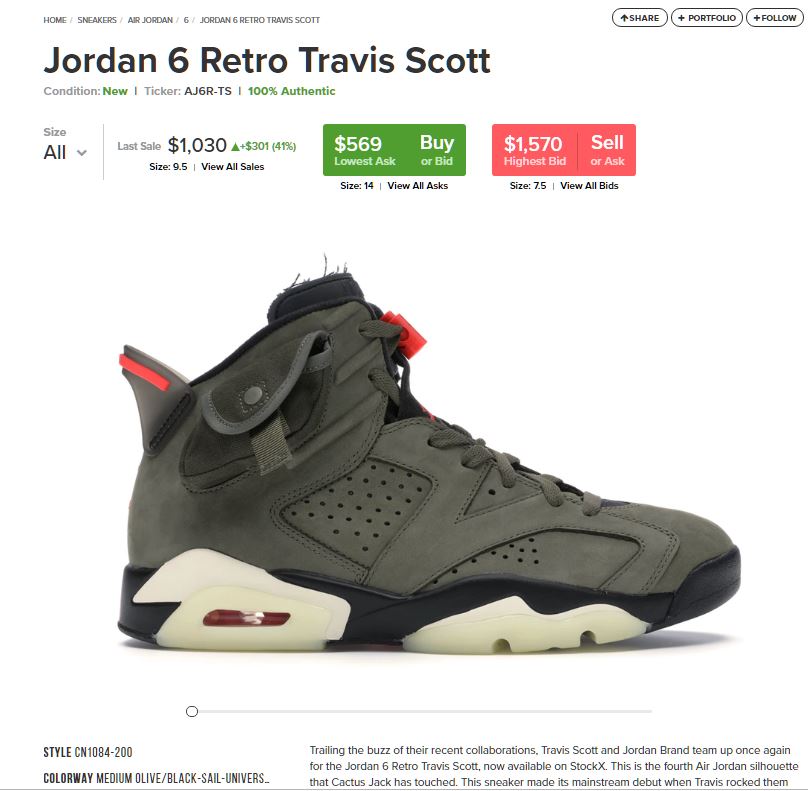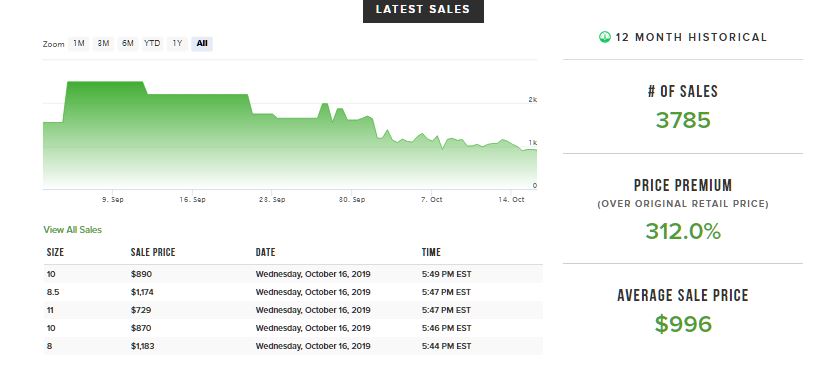StockX – Trading Exchange for Sneakers

Buy high, sell higher. Sneakers are too big to fail! – Overheard in a Nike elevator, probably.
What is StockX?
Founded in 2015, StockX is a marketplace platform for buying and selling hard-to-find consumer products, most often limited-edition sneakers. The platform is popular among sneakerheads, a community of people who collect sneakers as a hobby. Despite playing in a niche market, StockX has gained an astounding amount of traction. With an estimated 14.4 million monthly unique visitors [1], StockX serves as the community’s center of gravity for buying/selling high-priced sneakers and streetwear.
How does StockX work?
StockX’s website and mobile app facilitate trades in a manner that is very much similar to that of a stock exchange.
- Sellers list goods such as sneakers, watches and handbags on the exchange at a desired ask price. The physical condition of the goods must fulfill the specified product guidelines.
- Buyers submit bids on listings, specifying an expiry date, akin to a limit buy order on a stock exchange.
- Bid/Asks are published in real time. When there is match, which is to say, there is a buyer/seller pair that has the same willingness to buy/sell at a given price, a trade is automatically made. Both parties also have the option to buy/sell immediately at the lowest ask/highest bid respectively.
- Buyers pay StockX, who holds the funds in escrow
- Sellers have 2 business days to ship the goods to a StockX authentication center. 15% delay penalties apply otherwise.
- StockX verifies the accuracy, authenticity and condition of the goods, swaps out the shipping label and re-ships the parcel to the buyer.
- StockX releases payment to the seller, taking a commission of 8% to 17.5% on the invoiced amount [2], depending the seller’s ranking and the product category.

How does StockX create value and for whom?
Centralized marketplace
StockX’s basic value proposition is to act a centralized marketplace, thereby allowing buyers and sellers to meet and exchange goods for money. Sellers, who spend time and effort to obtain limited edition goods from official stores are rewarded for their dedication to the hobby, especially with most sneakers selling 10 – 50% above retail prices. On the other hand, buyers from all over the world gain access to their cult favorites, at a price they are willing to pay.
Publishing transaction data
By publishing historical and current bid/ask price as well as trade volumes (even for different shoe sizes), StockX demystifies supply and demand for buyers and sellers. Price transparency levels the playing field for novice sneakerheads to transact fairly with veterans. No longer does price information asymmetry allow veterans with expert knowledge take advantage of novices – buyers and sellers may simply look at the price of a pair of sneakers to assess its scarcity.
Curating selection of goods available
Not every sneaker brand/model can be listed on StockX. The company carefully curates the scope of items that can be listed on the platform, thereby facilitating product discovery for buyers. While some buyers may visit StockX with a particular item in mind, others visit to browse the selection and get inspiration for their next purchase. Similarweb.com estimates that the average StockX visitor spends about 4.12 minutes per visit [1].
Authentication of goods / Facilitating payment and escrow
By acting as a physical clearing house that ensures that buyers/sellers fulfill their respective obligations, StockX, it significantly reduces the counterparty risk in a market where fake goods are common. Sellers can rest assured that they will be paid promptly while buyers can purchase with confidence that they will get authentic goods of good quality and shipped on time to boot.
Logistics and customer service
StockX provides logistics and customer service infrastructure for its users, creating value through economies of scale. Sellers use shipping labels prepared by StockX to send in their wares to an authentication center. Buyers can contact StockX customer service to follow up on orders.
How is StockX different from most platforms?
Disintermediation
As StockX controls a significant portion of the value chain, buyers and sellers are anonymous to one another, which prevents disintermediation. In addition, given the broad and irregular demand of any given pair of sneakers, the risk of disintermediation is low even if buyers and sellers were to be in direct contact with one another.
Scarcity signaling
Manufacturers such as Adidas intentionally limit production runs to create hype about their sneaker design. By bringing price transparency to the market, StockX has become the industry benchmark to quantify this artificial scarcity, thereby cementing its position as the arbiter of cool in a market where cool is currency. Ironically, as these sneakers are aspirational goods, it is often the price that signals scarcity instead of vice versa. Some sneakerheads would pay $500 for a pair of shoes because of its price, not in spite of it.

[1] “Stockx.Com Traffic Statistics”. Similarweb. https://www.similarweb.com/website/stockx.com#overview.
[2] “Stockx Help”. 2019. Stockx. https://help.stockx.com/s/article/What-are-StockX-selling-fees?language=en_US.





How and where do you buy limited edition shoes, if not on this webpage. It seems like there is a potential business opportunity of buying as many of these limited edition shoes and posting them on this site.
Building off of MAO’s comment, how does StockX compete with the likes of a company like Farfetch (which acquired Stadium Goods) which has direct relationships with retailers and also reaches buyers worldwide? Given the difficult of sourcing such limited edition releases, it’s interesting to consider what kind of advantages an individual might have in his or her ability to source. I am imagining lines out the door of a store in Soho versus someone witch more cache that is on a waiting list for such items.
Although I myself am not a sneakerhead, it’s been a really interesting phenomena to observe. I have one friend that has been collecting every Nike Air Jordan for well over 10 years and another former colleague that goes to extensive lengths to get his hands on limited edition releases. Perhaps it is because I am not a sneakerhead myself that I hadn’t heard of StockX, but I’m very aware of Stadium Goods and GOAT. Thank you for bringing this to my attention!
I also don’t know that much about sneakers and found this post really interesting! StockX seems like a very thoughtfully designed platform. I am wondering how Nike and Adidas feel about the fact that this reselling market is becoming so well established, and they are not the ones capturing the value? A platform like StockX definitely reinforces the “cool factor” of these shoes, but it seems like the sneaker companies are leaving a lot of money on the table.
Thanks for the great read!
It’s interesting how Stockx has been able to successfully target a niche market and differentiate itself from competitors like Grailed or theRealReal. While the UI seems to be quite novel, the concept itself sounds pretty similar to other auction sites like eBay. It’s interesting that StockX has been able to change certain elements that seem minor to create a new marketplace. Perhaps this also part of the culture, but I find it amazing to think how obsessed buyers and sellers are with the products. In the example you show, the delta in the bid/ask in the Retro Travis Scotts is $1k. I can definitely see the value creation provided by StockX given hard it must be to find a match, given the scarcity of any particular product.